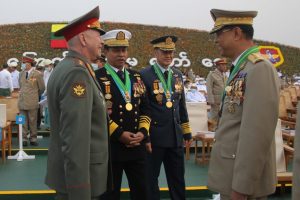Earlier this month, the leader of Myanmar’s ruling military junta, Senior Gen. Min Aung Hlaing, went to Russia in order to expand his regime’s defense and energy cooperation with Moscow. The relationship is most definitely lopsided and Moscow has not been willing to publicly embrace Min Aung Hlaing’s regime just yet. During his visit last week, the general was not granted a meeting with Russia’s President Vladimir Putin, and Russia downplayed the visit as a “private” one.
Yet, since the coup last February, Russia has been using its military might to expand its influence in Myanmar by sponsoring the junta’s operations. Moscow has supplied drones, fighter jets, and armored vehicles to the military regime, according to one United Nations expert. Russia has also thwarted statements at the U.N. Security Council aimed at Myanmar’s humanitarian crisis. The two governments are now united by their fight against Western sanctions and find themselves with expanding common ground.
Russia’s support is vital to the Myanmar junta, which is fighting a war of attrition against sundry rebels in the country’s complex ethnic landscape. So far, it has killed more than 2,000 civilians, according to U.N. officials. Yet, in the face of guerrilla warfare from multiple quarters, the military has struggled to establish its control outside provincial centers.
A steady stream of weapons from Moscow is key to the junta’s plans, and some experts believe that it has transferred raw materials to Russia in exchange, so as to circumvent sanctions. On his latest visit, Min Aung Hlaing even sought support in establishing nuclear energy to revive his war-ravaged economy.
For Russia, Myanmar’s geographical location is a strategic boon. Nestled between India and China, with a coastline facing the Bay of Bengal, Myanmar has access to both the Indian Ocean and the maritime trade routes leading into the South China Sea.
The Myanmar junta’s relative isolation post the coup also makes it a soft target for Moscow. Since the coup, the military government has largely relied on China. Under the democratically elected government headed by Aung San Suu Kyi, Myanmar had whittled down the scope of various Chinese projects under the Belt and Road Initiative (BRI). After the military takeover, the junta revived and expedited several of those projects.
Yet, the military remains wary of putting all its eggs in Beijing’s basket. Unlike Russia, which has maintained military ties only with the junta, China has armed and engaged with rebel militias as well. For the junta, a diversification of ties by moving closer to Moscow is a welcome prospect – and Russia has begun responding favorably.
Meanwhile, opposition fighters have been disappointed by the lack of international support for their cause, despite sanctions and lofty rhetoric from the West. The opposition People’s Defense Forces and other rebel militias were recently successful in recruiting about 100,000 fighters. Yet, only about 40 percent of them are said to have even small arms. In the absence of much support from the West, resistance groups have been forced to rely on public donations.
America’s goodwill amongst Myanmar’s rebel forces is compounded by its contrasting attitude toward Ukraine. Since the beginning of Russia’s invasion in February, the U.S. has poured in over $7.3 billion in military assistance, including – more recently – long-range missiles and artillery that are helping annihilate Russian targets in southern Ukraine.
By comparison, many analysts believe that a fraction of that support will be sufficient to take down the junta in Myanmar. “A supply of 50–100 Stinger-like missiles and a few thousand military-grade M4 automatic rifles would be enough for them to overthrow the military junta,” wrote one analyst, Michael Martin, at the Center for Strategic and International Studies. Yet, so far, the U.S. has been reluctant to enter the fray.
Washington’s absence has left Russia with the strategic space to consolidate its own allies and proxies. In the immediate aftermath of the Ukraine invasion, the Myanmar military junta was among Putin’s most vocal supporters. “Russia has worked to consolidate its sovereignty,” a spokesperson for the regime had said at the time. “I think this is the right thing to do.”
If the junta is able to prevail in Myanmar with Russia’s support, it would strengthen Putin’s hand in a region where he already enjoys some goodwill. Across the rest of the Indo-Pacific, countries such as India and Indonesia have maintained close ties with Moscow, despite Western sanctions.
If the Biden administration is serious about achieving its objectives in the Indo-Pacific, it would need to counter Russia’s stealthy expansion of power in Myanmar more purposefully. A good starting point would be to engage more proactively with the opposition and help meet its needs.
































